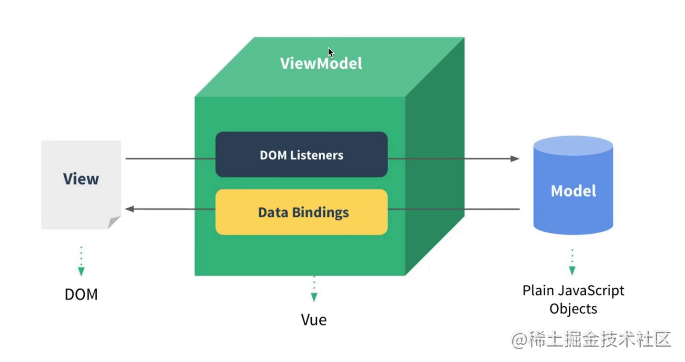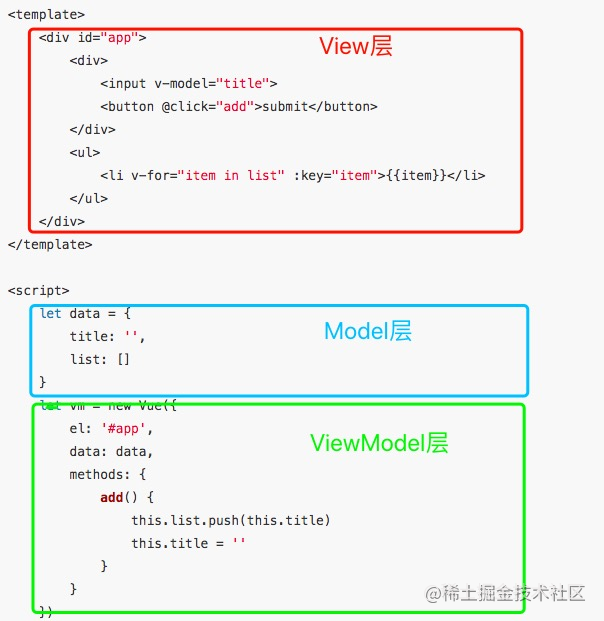Vue.js中MVVM
慕晨同学 人气:0MVVM的理解

MVVM拆开来即为Model-View-ViewModel,有View,ViewModel,Model三部分组成。View层代表的是视图、模版,负责将数据模型转化为UI展现出来。Model层代表的是模型、数据,可以在Model层中定义数据修改和操作的业务逻辑。ViewModel层连接Model和View。
在MVVM的架构下,View层和Model层并没有直接联系,而是通过ViewModel层进行交互。ViewModel层通过双向数据绑定将View层和Model层连接了起来,使得View层和Model层的同步工作完全是自动的。因此开发者只需关注业务逻辑,无需手动操作DOM,复杂的数据状态维护交给MVVM统一来管理。在Vue.js中MVVM的体现:

MVVM的原理
在不同的框架当中,MVVM实现的原理是不同的:
脏检查机制:
Angular.js就是采取的脏检查机制,当发生了某种事件(例如输入),Angular.js会检查新的数据结构和之前的数据结构是否发生来变动,来决定是否更新视图。
数据劫持
Vue.js的实现方式,对数据(Model)进行劫持,当数据变动时,数据会出发劫持时绑定的方法,对视图进行更新。
相同点
脏检查机制和数据劫持是有许多相同点的,例如,它们都有三个步骤:
- 解析模版
- 解析数据
- 绑定模版与数据
实现MVVM
<!DOCTYPE html>
<html lang="en">
<head>
<meta charset="UTF-8">
<title>Two-way data-binding</title>
</head>
<body>
<div id="app">
<input type="text" v-model="text">
{{ text }}
</div>
<script>
function observe (obj, vm) {
Object.keys(obj).forEach(function (key) {
defineReactive(vm, key, obj[key]);
});
}
function defineReactive (obj, key, val) {
var dep = new Dep();
Object.defineProperty(obj, key, {
get: function () {
if (Dep.target) dep.addSub(Dep.target);
return val
},
set: function (newVal) {
if (newVal === val) return
val = newVal;
dep.notify();
}
});
}
function nodeToFragment (node, vm) {
var flag = document.createDocumentFragment();
var child;
while (child = node.firstChild) {
compile(child, vm);
flag.appendChild(child);
}
return flag;
}
function compile (node, vm) {
var reg = /\{\{(.*)\}\}/;
// 节点类型为元素
if (node.nodeType === 1) {
var attr = node.attributes;
// 解析属性
for (var i = 0; i < attr.length; i++) {
if (attr[i].nodeName == 'v-model') {
var name = attr[i].nodeValue; // 获取v-model绑定的属性名
node.addEventListener('input', function (e) {
// 给相应的data属性赋值,进而触发该属性的set方法
vm[name] = e.target.value;
});
node.value = vm[name]; // 将data的值赋给该node
node.removeAttribute('v-model');
}
}
new Watcher(vm, node, name, 'input');
}
// 节点类型为text
if (node.nodeType === 3) {
if (reg.test(node.nodeValue)) {
var name = RegExp.$1; // 获取匹配到的字符串
name = name.trim();
new Watcher(vm, node, name, 'text');
}
}
}
function Watcher (vm, node, name, nodeType) {
// this为watcher函数
Dep.target = this;
// console.log(this);
this.name = name;
this.node = node;
this.vm = vm;
this.nodeType = nodeType;
this.update();
Dep.target = null;
}
Watcher.prototype = {
update: function () {
this.get();
if (this.nodeType == 'text') {
this.node.nodeValue = this.value;
}
if (this.nodeType == 'input') {
this.node.value = this.value;
}
},
// 获取daa中的属性值
get: function () {
this.value = this.vm[this.name]; // 触发相应属性的get
}
}
function Dep () {
this.subs = []
}
Dep.prototype = {
addSub: function(sub) {
this.subs.push(sub);
},
notify: function() {
this.subs.forEach(function(sub) {
sub.update();
});
}
};
function Vue (options) {
this.data = options.data;
var data = this.data;
observe(data, this);
var id = options.el;
var dom = nodeToFragment(document.getElementById(id), this);
// 编译完成后,将dom返回到app中
document.getElementById(id).appendChild(dom);
}
var vm = new Vue({
el: 'app',
data: {
text: 'hello world'
}
});
</script>
</body>
</html>总结
加载全部内容